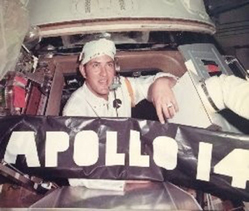
Press Room
FOR IMMEDIATE RELEASE: January 3, 2020
MEDIA CONTACT: Cody Hefner (513) 608-5777, chefner@cincymuseum.org
Apollo 11 spacecraft engineer visits Cincinnati Museum Center Jan 11 & 12
Lectures and gallery talks in Destination Moon exhibition
CINCINNATI – One man was at the center of every Apollo launch leading up to and through NASA’s historic Moon landings and he is coming to Cincinnati Museum Center (CMC). Dick Hagar is a spacecraft engineer, trainer of astronauts and historical witness to both successful and tragic rocket launches.
 Hagar will share his expertise and stories in lectures at CMC on January 11 and 12. Immediately following each lecture, he will be available in the Destination Moon: The Apollo 11 Mission exhibition for gallery talks, discussing his deep first-hand knowledge of the Apollo 11 command module Columbia. The lectures and gallery talks are included with admission to Destination Moon. Lectures are at 11 a.m. and 1 p.m. both Saturday, January 11 and Sunday, January 12.
Hagar will share his expertise and stories in lectures at CMC on January 11 and 12. Immediately following each lecture, he will be available in the Destination Moon: The Apollo 11 Mission exhibition for gallery talks, discussing his deep first-hand knowledge of the Apollo 11 command module Columbia. The lectures and gallery talks are included with admission to Destination Moon. Lectures are at 11 a.m. and 1 p.m. both Saturday, January 11 and Sunday, January 12.
In his 12 years at NASA, Hagar worked on every Apollo launch, from Apollo 1 through 17. He was near the Apollo 1 command module when it burst into flames in January 1967, killing astronauts Virgil “Gus” Grissom, Ed White and Roger Chaffee. Hearing the alarm calls on the radio communications, Hagar ran toward the launch pad but was blown back when an oxygen tank on the craft exploded. After the fire was extinguished, Hagar was one of the first to the spacecraft and was part of the investigative team searching for the cause of the fire. He and other NASA engineers applied those lessons learned during their investigation to a redesign of the Apollo command module, which were tested on several unmanned flights before sending the first astronauts into space aboard the spacecraft with Apollo 7.
In his role, Hagar worked with Apollo 11 astronauts Neil Armstrong, Buzz Aldrin and Michael Collins, training them on the Apollo command module’s systems. He was one of many who helped make the historic lunar landing possible. And one of the few to make five more landings possible, safely sending 33 Apollo astronauts into space and returning them home.
Prior to joining NASA, Hagar, originally from Delaware, Ohio, served in the U.S. Navy, working on A-3 Vigilante bombers. As an electronics engineer he worked on the bomber’s electronics systems, performing maintenance and repairs. In 1966 he moved to Florida to work on the Apollo program as a command module electrical engineer. His primary role was to train astronauts on the flight systems and computers.
If you can’t make it to Hagar’s talks, you can still see the Apollo 11 command module Columbia, Aldrin’s iconic gold-visored helmet and gloves and more than a dozen other artifacts flown aboard the historic mission in Destination Moon: The Apollo 11 Mission before it closes February 17.
Visit cincymuseum.org/destination-moon to purchase tickets or to learn more.
About Cincinnati Museum Center
Cincinnati Museum Center (CMC) at Union Terminal is a nationally recognized institution and national historic landmark. Dedicated to sparking community dialogue, insight and inspiration, CMC was awarded the 2009 National Medal for Museum and Library Service from the Institute of Museum and Library Services and received accreditation from the American Alliance of Museums in 2012. CMC is one of a select few museums in the nation with both of these honors, making it a unique asset and a vital community resource. Union Terminal has been voted the nation's 45th most important building by the American Institute of Architects. Organizations within CMC include the Cincinnati History Museum, Duke Energy Children's Museum, Museum of Natural History & Science, Robert D. Lindner Family OMNIMAX® Theater and Cincinnati History Library & Archives. Recognized by Forbes Traveler Magazine as the 17th most visited museum in the country, CMC welcomes more than one million visitors annually. For more information, visit www.cincymuseum.org.
Marketing Communications
Cody Hefner
Director of Communications
(513) 287-7054
chefner@cincymuseum.org
Are you requesting a donation or tickets for your event? Please fill out this form.
Are you interested in renting Union Terminal for a private event? Click here for more information
Museum Admission
Includes Cincinnati History Museum, Museum of Natural History & Science and The Children's Museum
| Adult: | $22.50 |
| Senior: | $15.50 |
| Child: | $15.50 |
| Member Adult: |
FREE |
| Member Child: |
FREE |
Members receive discounts!
Become a Member today to save on programs, exhibits and films throughout CMC.
Museum Hours
Open Thursday – Monday
10 a.m. to 5 p.m.
Closed Tuesday and Wednesday
Closed Thanksgiving Day and Christmas Day
Member’s-only early entry: Saturdays at 9 a.m.
Customer Service Hours:
Monday – Sunday, 9 a.m. to 5 p.m.
